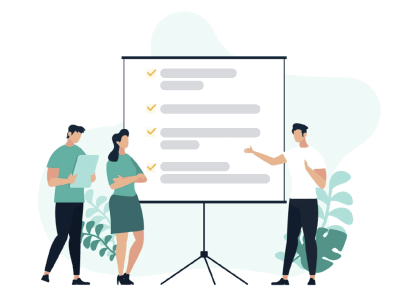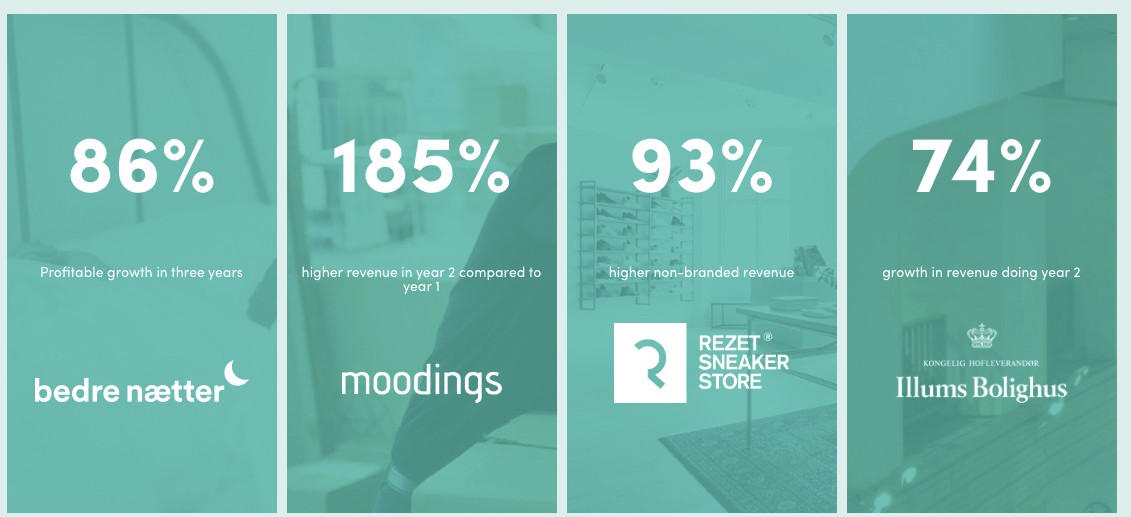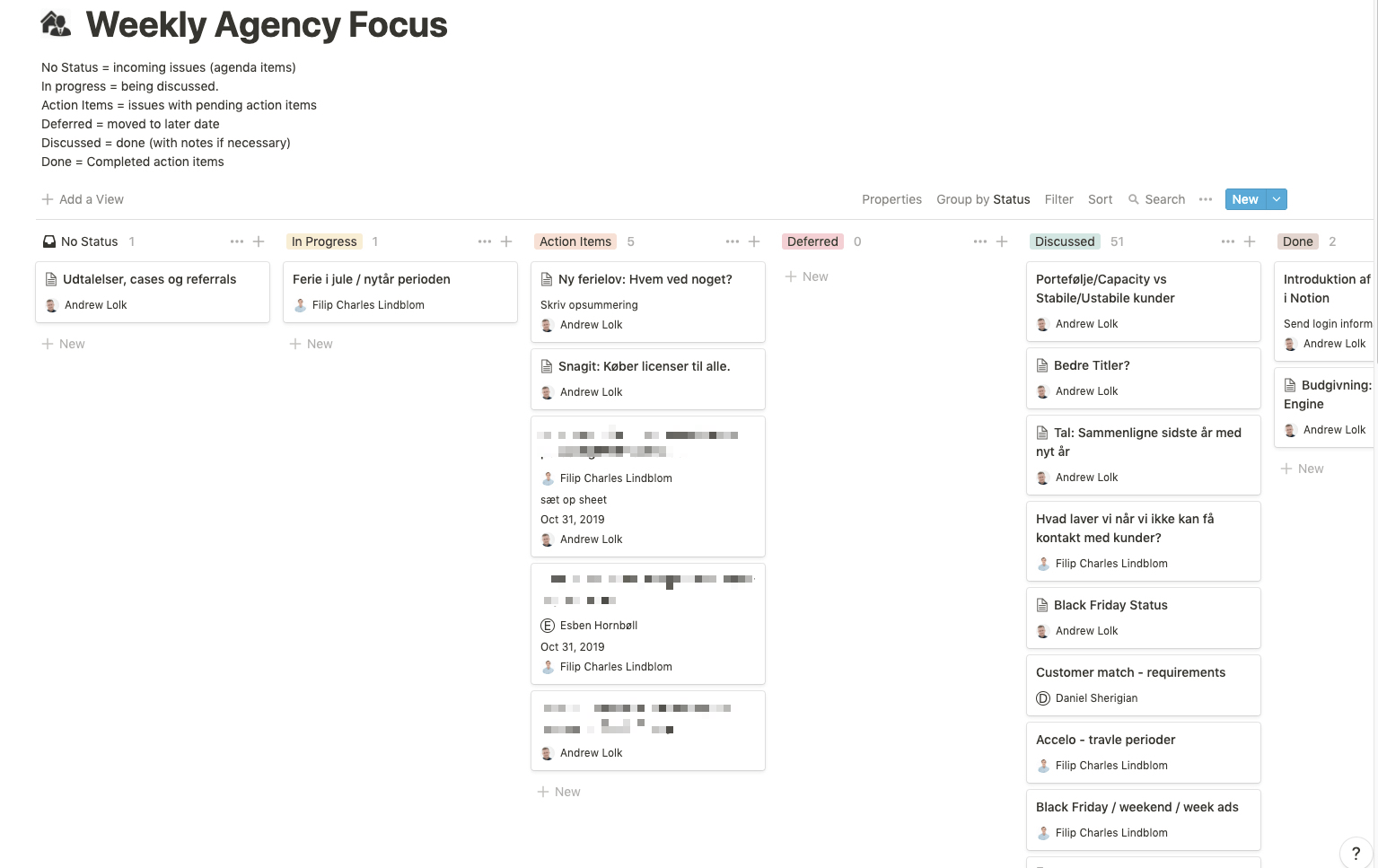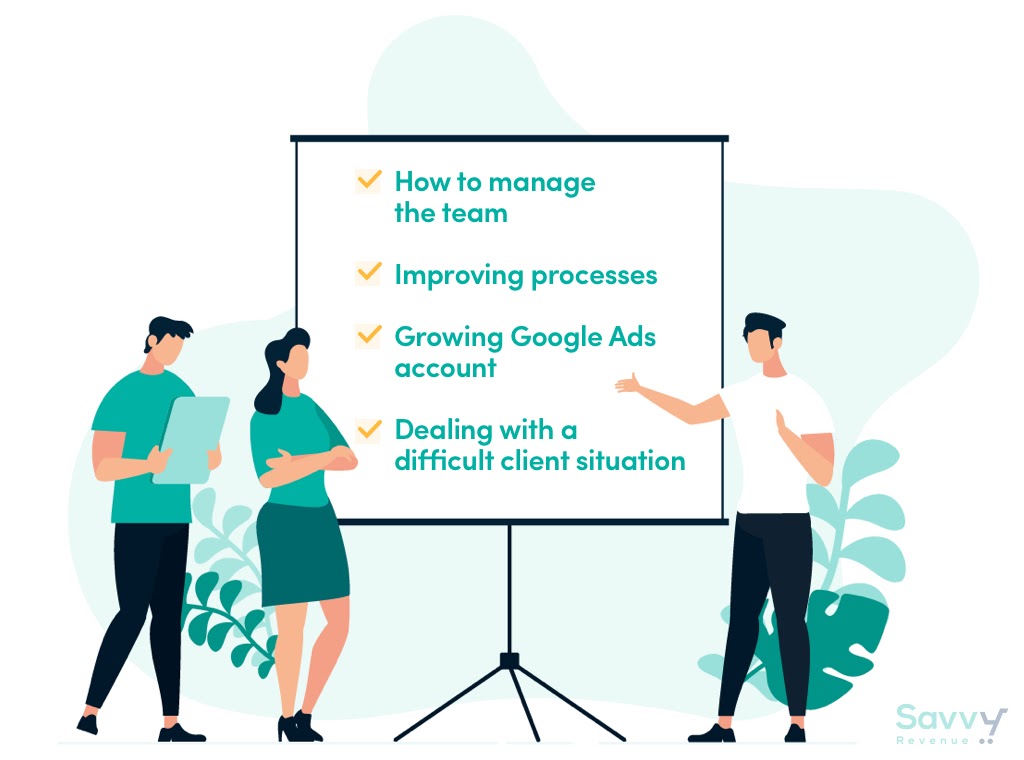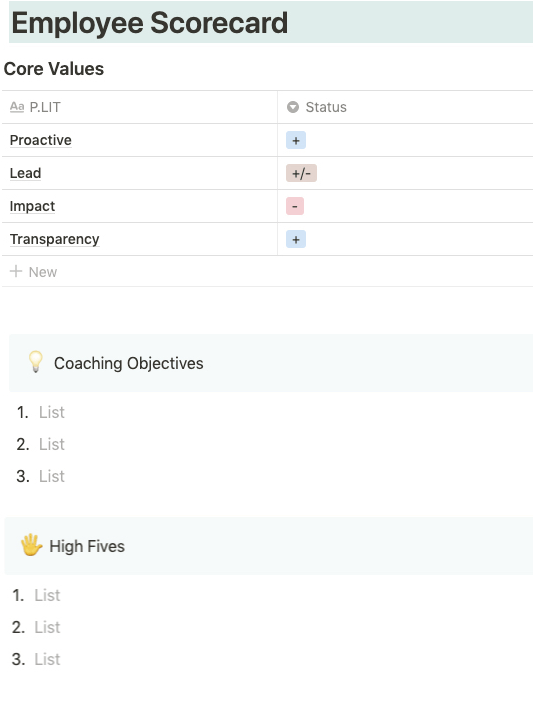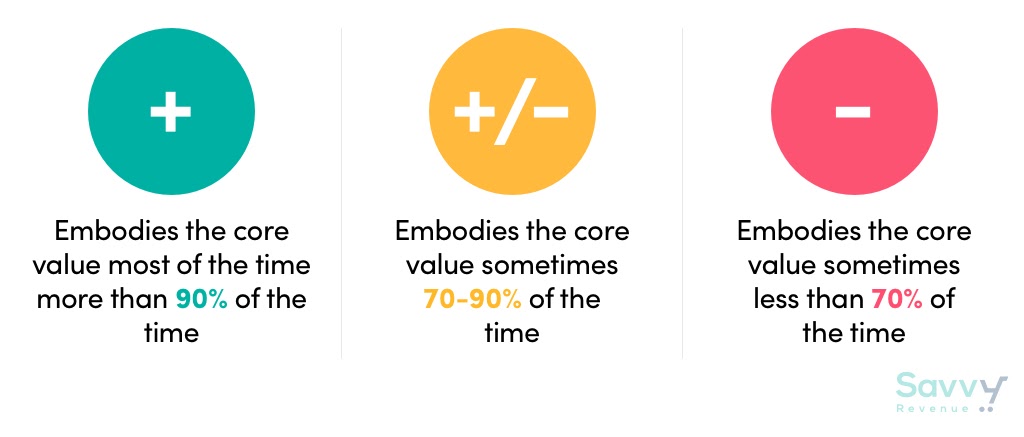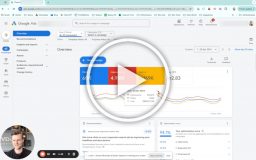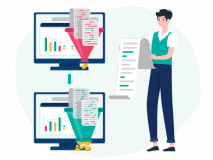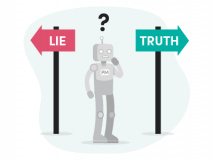I’ve owed an update for a couple of months now. We’ve had a lot of exciting things happen, but I kept adding, changing, and updating this post. Before I knew it, we were halfway through Q4, and I thought an annual update might be better.
As always, I try to make these posts focused on direct lessons you can implement in your agency or consultancy instead of a traditional “ look at us” year in review.
If you like this post, I recommend reading the previous updates:
- Starting a PPC Agency: From Thriving 8-Figure PPC Agency to Starting from Scratch
- Six months, $256,000 ARR and 24 Key Learnings Later
- Learnings Going from 2 to 6 and 100% Annual Growth at $515,000 ARR (Agency Startup Update)
2019 by the Numbers
Revenue: We hit just shy of our target of 5.050 million DKK. We hit 4.800 million DKK.
A big reason why we fell behind was because we unexpectedly lost five clients over the summer (which is more clients than we have ever lost overall.I go into more details with this later). As an agency, we’ve never churned many clients that we didn’t proactively cancel ourselves.
We stayed at our employee count throughout the year. We could have hired on several occasions but decided to focus more on improving our portfolio than simply hiring more. A future post will include our strategy on portfolio optimization.
Some positive highlights from 2019 include:
- We got very far with automation. Almost everything within search and shopping has been automated, so we can focus on strategy and executing within the areas that benefit from human insights.
- The team is working well together, and we are looking at a strong team that is able to execute.
- Our processes and overall business foundation has been laid to a much greater degree than before. We implemented a CRM, business processes, Google Ads processes, and much more.
- We promoted our first “junior” employee and are seeing a lot of potential from Daniel S. in 2020. We’re excited about the potential of taking our own people from “juniors” to “seniors.”
- Responsibilities are becoming clearer and better assigned between my right hand and me. 2019 started with a lot of grey areas, but the more Filip works with the team and operations, the less I’ve had to be in there.
Plus a lot more, but these were some of the highlights.
Not everything was great, though.
We Lost Five Clients During the Summer (and lived to tell the tale)
During the summer, we lost five clients.
That’s more than we lost the previous two years in total.
Some might say I’m crazy for sharing our worst three month period in our existence.
Why portray all the bad?
Well, because it’s the truth.
We have good times, and we have bad times.
We still sit with amazing results for our clients:
But we lost five clients (not related to the screenshot above):
- Client A was a longtime client, but we didn’t act fast enough on some of their hints, so they took it in-house again.
- Client B didn’t see a big enough performance boost to make it worth their while.
- Client C had seasonality challenges and a huge influx of competitors to their narrow space that made it very hard for us to determine if we were a profitable investment.
- Client D had a former employee who started his own agency and underbid us while mimicking everything we did. Touché.
- Client E was convinced by a rogue salesman that they could do it better.
The funny thing is that this is in stark contrast to the month of May. If we had won just two of the pitches we were a part of in May, I don’t know how we could have delivered on our promises.
So in the span of three months, we went from being (almost) stretched beyond our capabilities to sitting around wondering what to do next.
The issue was amplified by the fact that it was summer, and even though we started getting a couple of prospective clients to reach out to us, they all said: I’m back in three weeks 🙂
It was like the perfect storm.
Another reason why I like to share these moments is to make sure other people who run agencies or who want to start an agency don’t read my posts and think that everything is awesome.
Because running an agency is not a Lego Movie.
There are issues.
There are challenges.
There are setbacks.
We all experience them. I’ve talked to many agencies in the last eight years, and all have experienced these setbacks. Even the most successful agencies today are struggling with something big at one time or another. And not the cute, “Oh, we can’t hire fast enough to keep up with our growth” kind of struggle. No, real struggle as in how are we going to make payroll next month or we have to cut back.
It happens to everyone and will happen to you, too.
We hit a slump. I never thought we’d actually hit it because we had been looking ahead across the board.
So What Did We Do?
We restarted content and hired the former editor of SearchEngineJournal.com to help steer it throughout the year. We then took the next step, which was to hire an Inbound Marketing manager to run it in-house as we saw to expand into more education in 2020.
I feel that a big part of being an agency is to be an authority on the services you deliver. We, therefore, don’t outsource the actual writing, but the management of the content program.
The same goes for running an in-house inbound marketing team. You shouldn’t ask them to produce content – especially as an agency. You’re selling your competencies. You should put those competencies on display, which you can’t expect somebody who isn’t an expert in your field to do.
That is why – in my opinion – that the internet is flooded with listicles and other bad content.
We Reached Out for Referrals
Referrals are something we don’t ask enough for. Partly because I want to make sure we grow outside of referrals, but also because we’ve lacked a process for it.
But being on our butts, we asked for referrals. At first, we were told by several that they didn’t know anybody (again – summer in Denmark), but the second we hit August, we started seeing referrals coming in and by October, we had signed three clients from referrals.
Continued To Focus on Content
It’s crazy how well content works for us. I can’t prove it. I can’t point to it and say that’s where XYZ client came from.
But what I can do is look in our email list and say that client Y that came in in October has been on our email list since 2018.
And that goes for almost all our existing clients. They are either connected (and active) with me on LinkedIn, or they consistently read our blog posts.
So for 2020, we will double-down on our best content: Actionable with real insights from running eCommerce ad accounts.
This article expands my thinking beautifully on overall lead generation for agencies: https://econsultancy.com/agencies-work-vs-resource-business-development/
I Learned to Assign Part of Our Fee to Maintaining the Status Quo
We focus on growth at Savvy. The majority of our clients come to us because they want to grow profitably, and we deliver.
But we also need to reflect a bit on this. We had a major eCommerce store ask us whether we would even work with them because they weren’t as focused on growth, but more in the 10-20% range and needed someone to help automate their account.
Yikes. Talk about a flaw in our messaging. That’s a dream client for us.
There are cases where the reason to engage with us aren’t simply because you want to grow:
- You have had a bad experience with your agency (one client was cut short in a quarterly meeting right after he had increased their fee – performance was good, but he had lost the personal connection with them)
- You do well now, but you fear whether they can keep up
- Your in-house employee is leaving
- You’re looking for direct contact with the person working on your account
- You want to future-proof your account by implementing more automation (something we are particularly good at doing)
Etc.
We weren’t good enough to recognize those cases, and I would go headfirst into our growth pitch with new prospects.
That was a mistake.
I set up two cases where the only successful outcome would be a 50% increase in revenue when everyone would have been happy with a lot less.
I believe we should be better at identifying the few cases where maintaining the status quo or growing by 10-20% year-over-year would be a success.
This will also start reflecting in the cases that we portray on the website. We’ll highlight more of the cases where we achieve 10-30% growth instead of solely showcasing the home runs.
Maintaining Revenue Should Be Valued
Whenever we talk to long-term clients about it, they also state it themselves. They base 50-75% of their non-brand revenue on Google Ads. So, the reassurance that we are there to help maintain their campaigns is a big factor they consider when deciding whether we are profitable to work with.
Super Insightful Resource: Hint – It’s not Facebook Groups!
I hate Facebook Groups. The quality of advice ranges from horrible to great, and there is no way to determine the validity of the person giving you advice.
A fellow (albeit only 50%) Dane like myself, Johnathan Dane (his last name is literally Dane), and Ross Hudgens started a course for agency owners and freelancers.
Here are two facts:
Johnathan has grown KlientBoost to $5M in annual revenue faster than we did at White Shark Media.
Ross is running a 70-person content and link-building agency and recently hit $10M ARR with around 40 clients.
That’s really impressive.
So when they started an agency course with an adjoining Slack channel, I jumped on it. I think I was one of the first ten in there.
I still haven’t opened the course, but having access to like-minded agency owners is key.
I’m really not a fan of paying some guy $2,500 a month for putting together a “mastermind” just because he is good at online marketing himself. I tried it. It was a horrible investment and the group was four people on poor Skype connections. I left after the first group.
So if you are serious about growing your agency, check out the course at GrowthComet.com and stick around for the Slack group.
Being Remote for 10 Months
During the summer of 2018, my wife and I decided to move to the US permanently. We had been living in Nicaragua for eight years, but it was time to move on.
That meant that I had to get a permanent residence permit in the US. I was told that I would be able to travel out of the country within three months – max.
So I booked a speaking engagement in February, thinking I could easily make it. Didn’t happen.
I then booked a speaking engagement in May, thinking I could easily make it. Didn’t happen.
Long story short, I got my residence in September, about ten months later. I’m luckier than most, and the process was overall seamless. But it was ten months without meeting the team, seeing how they work, meeting clients, etc.
So what did I learn from running the company remotely for ten months:
Nothing beats face to face time
Filip joined me in August for some much-needed strategy work on the business in San Diego; almost four whole days locked in a meeting room to discuss where we want the business to go, what challenges we experienced, how to level up the team, and much more.
This time was invaluable.
I’m a huge whiteboard fan. I think much better when I can visually put words up on a whiteboard. It’s a bit odd. Somebody out there might have a name for this?
For that reason—and others—getting together in a room physically fits me much better than online meetings. I would never forego online meetings, and it’s definitely possible to have great meetings online—we do it every week—but there is just something about getting together physically.
Good equipment is key
We tried a number of fancy video conference equipment. I’m a huge equipment nerd, and I really like the best of the best, so it’s almost like the more expensive hardware is, the more I want it.
We tried the Logitech Rally, Polycom Studiobar, OwlLabs, etc.
In the end, we ended up simply using a $200 VoxBox, and $90 Logitech webcam. The sound and microphone on the VoxBox is great, always works, and the Logitech webcam creates almost as good a picture as the rest at a 10th of the price.
To many people’s defense, then I was explained this a number of times. I just thought they were being cheap 🙂
Steady meeting schedule
Even more so than with in-house work, you need to have a steady meeting schedule so everyone knows how and when to get a hold of each other.
Especially with a seven to nine hour time difference (which we had/have), then it’s crucial to set up meetings to discuss the important things. Otherwise, I would end up sending important notices on Slack, which nobody needs at 9:00 pm.
Also, getting replies from me on areas that required a more swift decision could quickly take two to four days as I don’t always respond to email first thing in the morning. If I don’t do that, then the team wouldn’t get a reply until the next day (their time).
Having a steady meeting schedule made it a lot easier, which I’ll expand upon next.
How to Run Better Meetings
I have run a lot of meetings in my years, and I have always been a fan of (good) meetings. A good meeting cadence ensures that everyone is in sync and that you can find a safe space with designated time and focus to discuss important topics.
The notion that all meetings are bad is like a meme gone bad. Just let it go.
Here is a couple of tips that we’ve utilized this year to run better meetings:
Not Everything is Equally Important
Ever since I signed my old agency up as the first client in the first agenda-management platform (do.com), I’ve always focused on having an agenda in meetings, but I never thought it was super effective.
Meetings would almost always go over its time slot, or we would have to rush from one agenda item to another.
It wasn’t until I read the book Traction and Gino Wickmann introduced the idea of IDS + Prioritizing your agendas.
The gist of it is that you have a list of issues (aka agenda items) in random order (which often will be in the order they were added to the list).
Our default for meetings was to discuss the easy things first or just start from the top.
But Traction teaches you to prioritize the top three issues you want to discuss first. These should be the most impactful, important issues.
It’s fine if you only go through one or three issues in 90 minutes as long as those are the most important issues that needed to be tackled. That way, no meeting will ever run late again.
You then IDS (Identify, Discuss, Solve) the issue. Meaning that you ensure you identify what the core issue is, discuss possible solutions to that specific issue you identified, and then define a solution.
We use Notion.so to help us with running these meetings:
I’ve created a quick video to showcase how it works:
See the video here
Employee Coaching and Profile
We are a service-based business. Our inventory is our people. The better, and more, people we have, the more inventory we have to sell. I learned that many years ago.
Therefore in order to grow, our number one thing we should focus on is how do we make our people better.
This really solves all other challenges:
The better we are at onboarding, training, and ongoing coaching, the better we can run our agency and grow.
I’ve run a lot of coaching programs, and the one thing that I determined looking at them today is that they were all too complicated.
They were created by an HR department or leadership team who wasn’t in the trenches. It meant two things:
- The coaching became too complicated
- More “fluff” was introduced
Seeing that Filip and I are the ones designing and implementing everything from a managerial standpoint at SavvyRevenue, we needed something simple.
And that’s what we built:
- We created four core values that we score everyone on
- All scores are kept to one of three choices
- Everyone gets one to three high fives every month
- Everyone gets one to three coaching objectives every month
And that’s it.
A coaching program doesn’t have to be complicated to work well. In its essence, a coaching program has to:
Give managers a method to help employees determine areas of improvement.
That’s it.
If the manager and the employee both know what the employee has to improve on, then a gameplan can be defined. A way to follow up can be set in place. A determination of whether it has happened can happen at a designated point in time.
The way it specifically looks is:
Every month, each employee gets a score for each of our core values. They are described as such:
- We lead the client
- We showcase a unique business understanding within the eCommerce space.
- We lead the client and guide them down the right path.
- We find the root cause of challenges, even when the root cause is not Google Ads related (wrong pricing, wrong ROAS target, etc.).
- We’re a strategic partner that the client leans on for more than just Google Ads.
- If less than 75% of all the work performed was not suggested by us, then we are not leading.
- We are transparent
- Is the performance low? Send the report with the actual numbers, take responsibility, and come up with solutions.
- New clients get an honest assessment of their potential.
- Everyone from owner to manager to employee is open and honest about everything.
- We are proactive
- A good plan allows you to make a greater impact rather than just doing weekly tweaking.
- A good plan gives you the freedom to focus on the task at hand instead of reinventing the wheel constantly.
- We proactively predict challenges and seasonality, and hit our deadlines because we have predicted them.
- We make an impact
- We don’t just perform tasks to fill the time. We perform tasks to make an impact on our client’s ROAS, revenue and/or profit.
- We balance the impact vs. time spent on tasks when determining how we should spend our time.
- We deliver good today, not “perfect tomorrow” solutions.
So besides defining what each person could improve on every month, we grade each person on how well we execute on our core values.
A simple +, +/- or – are enough.
With this method, employees will be measured with quantifiable data reflective of their performance.
Notice how there isn’t a churn number, revenue number, etc.?
That’s on purpose. We are scoring our people on their ability to execute on our four core values. That’s what matters to us. A client can cancel for a number of reasons. If a client cancels, then the only thing we could have done better was within one of our four core values.
So having another metric for the team’s churn rate is not necessary. It would just serve to make people feel bad or pressured for no reason. They’ll feel bad when they lose a client. That’s the culture we’ve built. We don’t need a company to tell us that.
Again, I want to mention that this works for us because we have three to seven clients per person, and we don’t really experience churn. If we were at 30-70 clients per person, then we would measure churn aggressively. But that’s not our game.
Where Do We Go in 2020?
A lot more of the same.
Our revenue target for 2020 is 50% growth based on 2019. This means 7.2 million DKK.
Our realistic forecast is set to 6.4 million DKK, which we would be happy with. There are factors in the budget that could easily push us to 7.2 million DKK, so we are happy with the current forecast.
We will hire two to three PPC managers for Denmark. Our first hire will be in March and the second over the summer. If we are trending better than our realistic forecast, then we will hire again on September 1st. We will primarily hire senior profiles, but this is sometimes hard. Depending on how hard this proves for the first two hires, then we will potentially hire employees with less experience and train them.
We want to introduce three new services: Roadmaps, In-house Sparring, and eCommerce Analysis.
This is primarily to have more services to offer across where a company is on their own journey. Newly companies will benefit from a Roadmap. Webshops with in-house teams can use either a roadmap or direct internal sparring for a period of time.
As we become more structured in our work, we want to be able to provide insights to in-house teams through Roadmaps and Sparring with in-house teams.
As much as we want to introduce more services, we have no plans to introduce SEO, Social, or other non-PPC services in 2020. If we find a strong lead within CRO, Social, or SEO, then we’ll consider it strongly, but it’s not in our current plans.
We will continue to focus on processes, onboarding, and ongoing coaching. We’ve worked on this in 2019, but need to continue working on our processes. Especially with making sure they are in the right format so that they are easy to read.
Lastly, we will double down on all marketing efforts. We’ve hired our first non-client facing employee for an inbound marketing role. We will get more consistent with blogging again, and will start launching webinars;we need to find another name. Again, the focus will be on actionable content with real insights from running eCommerce ad accounts.
Our thinking is the following: The more marketing efforts we push, the more leads we will get, which will set us in a better position of choosing our own clients.
